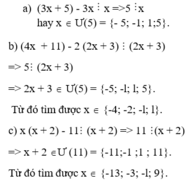Hãy nhập câu hỏi của bạn vào đây, nếu là tài khoản VIP, bạn sẽ được ưu tiên trả lời.

a) x Î Ư(6) = {-6; -3; -2; -l; l; 2; 3; 6}.
b) x + l Î Ư (8) = {- 8; -4; -2; -1; 1; 2; 4; 8}. Từ đó tìm được
x Î{-9; -5; -3; -2; 0; 1; 3; 7}.
c) x - 2 Î Ư(10) = {-10; -5; - 2; -1; 1; 2; 5; 10). Từ đó tìm được
x Î {-8; -3; 0; l; 3; 5; 7; 12}.

a, x+3 chia hết cho x-1
Ta có: x+3=(x+1)+2
=> 2 chia hết cho x+1
=>x+1 thuộc Ư(2)= {1, -1, 2, -2}
=> x thuộc {0,-2, 1, -3}
b.
b,3x chia hết cho x-1
c,2-x chia hết cho x+1
Ta có:
\(\dfrac{x+3}{x-1}=\dfrac{x-1+4}{x-1}=1+\dfrac{4}{x-1}\)
Để (x + 3) \(⋮\left(x-1\right)\) thì 4 \(⋮\left(x-1\right)\)
\(\Rightarrow\) x - 1 = 1; x - 1 = -1; x - 1 = 2; x - 1 = -2; x - 1 = 4; x - 1 = -4
*) x - 1 = 1
x = 2
*) x - 1 = -1
x = 0
*) x - 1 = 2
x = 3
*) x - 1 = -2
x = -1
*) x - 1 = 4
x = 5
*) x - 1 = -4
x = -3
Vậy x = 5; x = 3; x = 2; x = 0; x = -1; x = -3

`**x in NN`
`a)x+12 vdots x-4`
`=>x-4+16 vdots x-4`
`=>16 vdots x-4`
`=>x-4 in Ư(16)={+-1,+-2,+-4,+-16}`
`=>x in {3,5,6,2,20}` do `x in NN`
`b)2x+5 vdots x-1`
`=>2x-2+7 vdots x-1`
`=>7 vdots x-1`
`=>x-1 in Ư(7)={+-1,+-7}`
`=>x in {0,2,8}` do `x in NN`
`c)2x+6 vdots 2x-1`
`=>2x-1+7 vdots 2x-1`
`=>7 vdots 2x-1`
`=>2x-1 in Ư(7)={+-1,+-7}`
`=>2x in {0,2,8,-6}`
`=>x in {0,1,4}` do `x in NN`
`d)3x+7 vdots 2x-2`
`=>6x+14 vdots 2x-2`
`=>3(2x-2)+20 vdots 2x-2`
`=>2x-2 in Ư(20)={+-1,+-2,+-4,+-5,+-10,+-20}`
Vì `2x-2` là số chẵn
`=>2x-2 in {+-2,+-4,+-10,+-20}`
`=>x-1 in {+-1,+-2,+-5,+-10}`
`=>x in {0,2,3,6,11}` do `x in NN`
Thử lại ta thấy `x=0,x=2,x=6` loại
`e)5x+12 vdots x-3`
`=>5x-15+17 vdots x-3`
`=>x-3 in Ư(17)={+-1,+-17}`
`=>x in {2,4,20}` do `x in NN`
a) Ta có: \(x+12⋮x-4\)
\(\Leftrightarrow16⋮x-4\)
\(\Leftrightarrow x-4\inƯ\left(16\right)\)
\(\Leftrightarrow x-4\in\left\{1;-1;2;-2;4;-4;8;-8;16;-16\right\}\)
hay \(x\in\left\{5;3;6;2;8;0;12;-4;20;-12\right\}\)
Vậy: \(x\in\left\{0;5;3;6;2;8;20\right\}\)
b) Ta có: \(2x+5⋮x-1\)
\(\Leftrightarrow7⋮x-1\)
\(\Leftrightarrow x-1\in\left\{1;-1;7;-7\right\}\)
hay \(x\in\left\{2;0;8;-6\right\}\)
Vậy: \(x\in\left\{0;2;8\right\}\)
c) Ta có: \(2x+6⋮2x-1\)
\(\Leftrightarrow7⋮2x-1\)
\(\Leftrightarrow2x-1\inƯ\left(7\right)\)
\(\Leftrightarrow2x-1\in\left\{1;-1;7;-7\right\}\)
\(\Leftrightarrow2x\in\left\{2;0;8;-6\right\}\)
hay \(x\in\left\{1;0;4;-3\right\}\)
Vậy: \(x\in\left\{0;1;4\right\}\)
d) Ta có: \(3x+7⋮2x-2\)
\(\Leftrightarrow6x+14⋮2x-2\)
\(\Leftrightarrow20⋮2x-2\)
\(\Leftrightarrow2x-2\in\left\{1;-1;2;-2;4;-4;5;-5;10;-10;20;-20\right\}\)
\(\Leftrightarrow2x\in\left\{3;1;4;0;6;-2;7;-3;12;-8;22;-18\right\}\)
\(\Leftrightarrow x\in\left\{\dfrac{3}{2};\dfrac{1}{2};2;0;3;-1;\dfrac{7}{2};-\dfrac{3}{2};6;-4;11;-9\right\}\)
Vậy: \(x\in\left\{2;0;3;6;11\right\}\)
e) Ta có: \(5x+12⋮x-3\)
\(\Leftrightarrow27⋮x-3\)
\(\Leftrightarrow x-3\in\left\{1;-1;3;-3;9;-9;27;-27\right\}\)
\(\Leftrightarrow x\in\left\{4;2;6;0;12;-6;30;-24\right\}\)
Vậy: \(x\in\left\{4;2;6;0;12;30\right\}\)

a)<=>(x+1)+2 chia hết x+1
=>2 chia hết x+1
=>x+1\(\in\){1,-1,2,-2}
=>x\(\in\){0,-2,1,-3}
b)<=>3(x-2)+7 chia hết x-2
=>7 chia hết x-2
=>x-2\(\in\){1,-1,7,-7}
=>x\(\in\){3,1,9,-5}
c,d,e tương tự

Bài 1:
a: \(\Leftrightarrow x-1\in\left\{1;-1;3;-3\right\}\)
hay \(x\in\left\{2;0;4;-2\right\}\)
